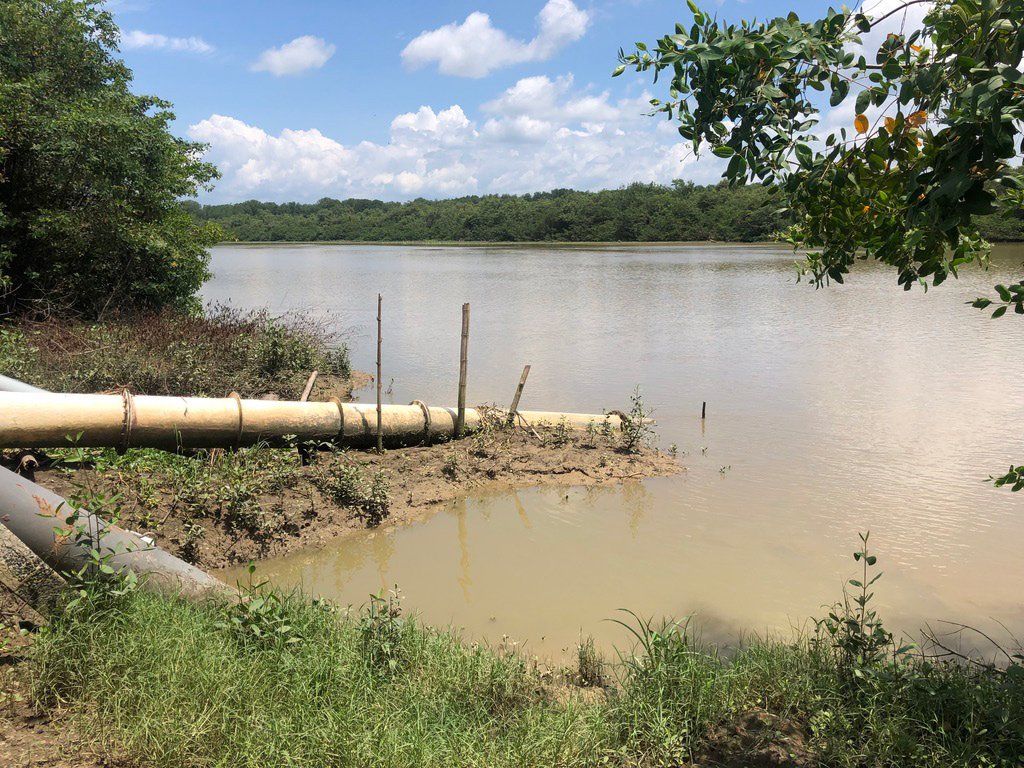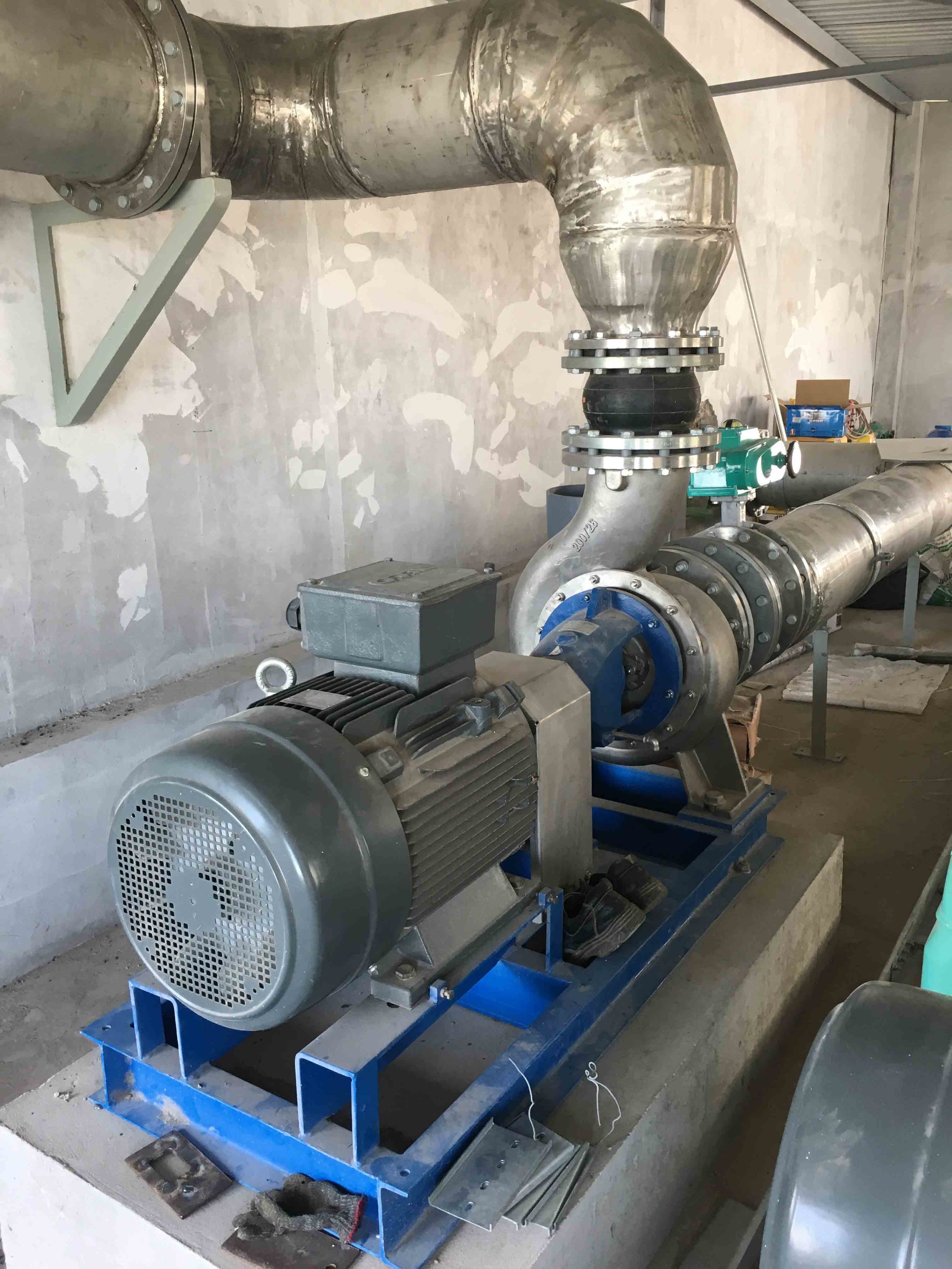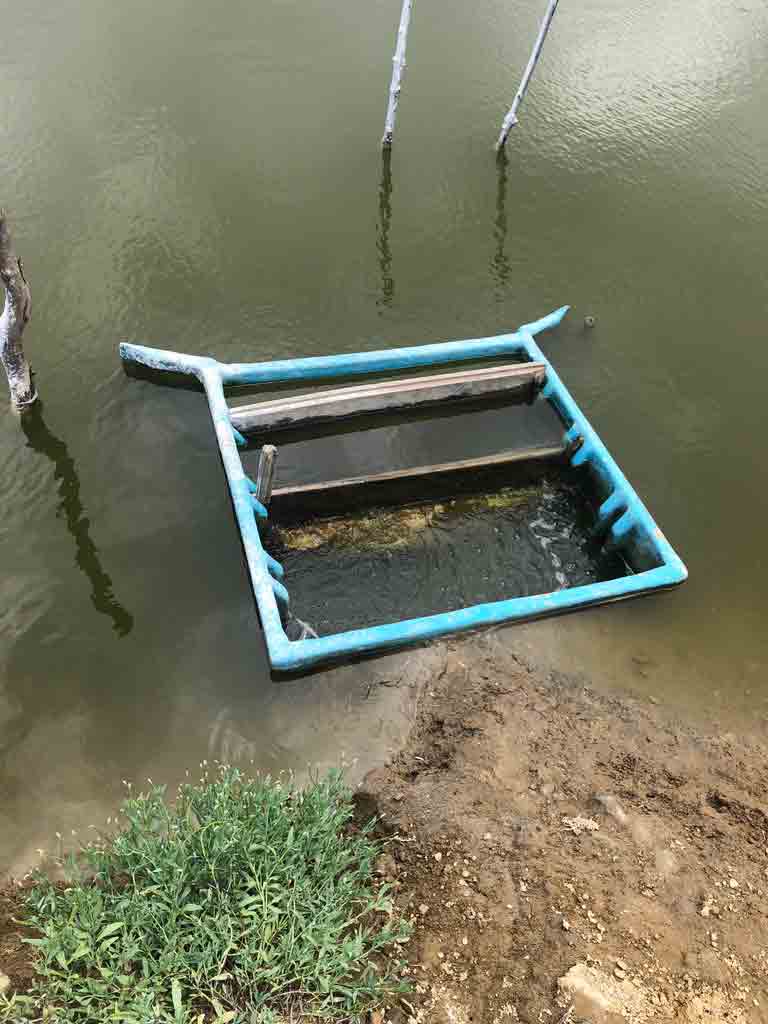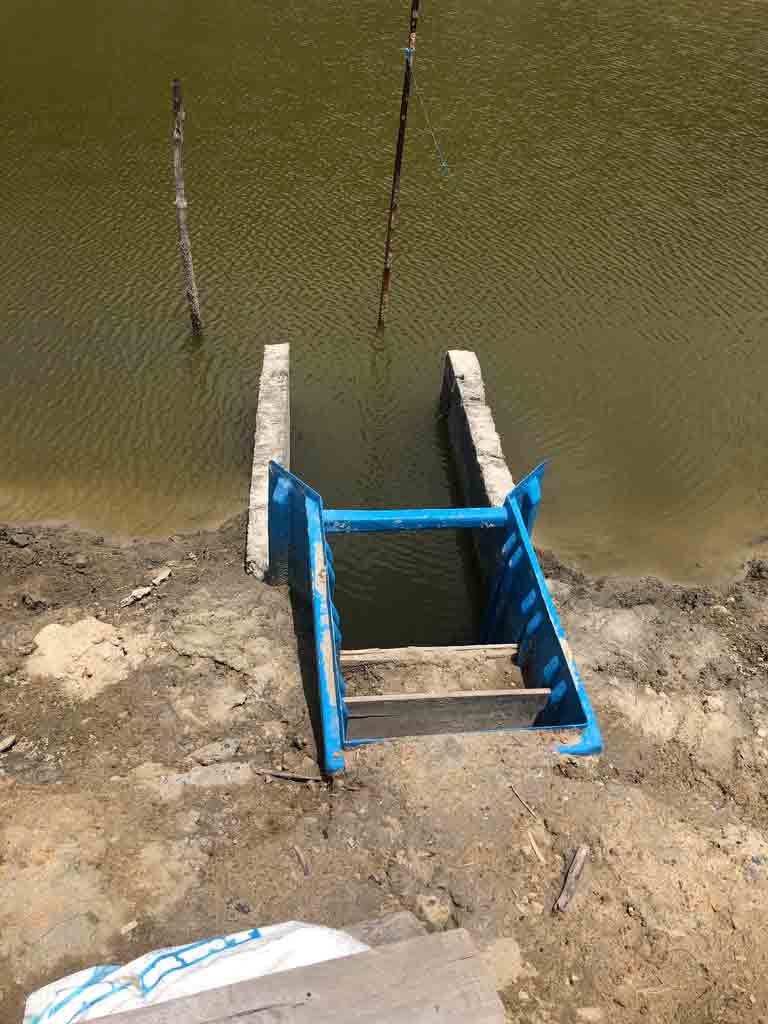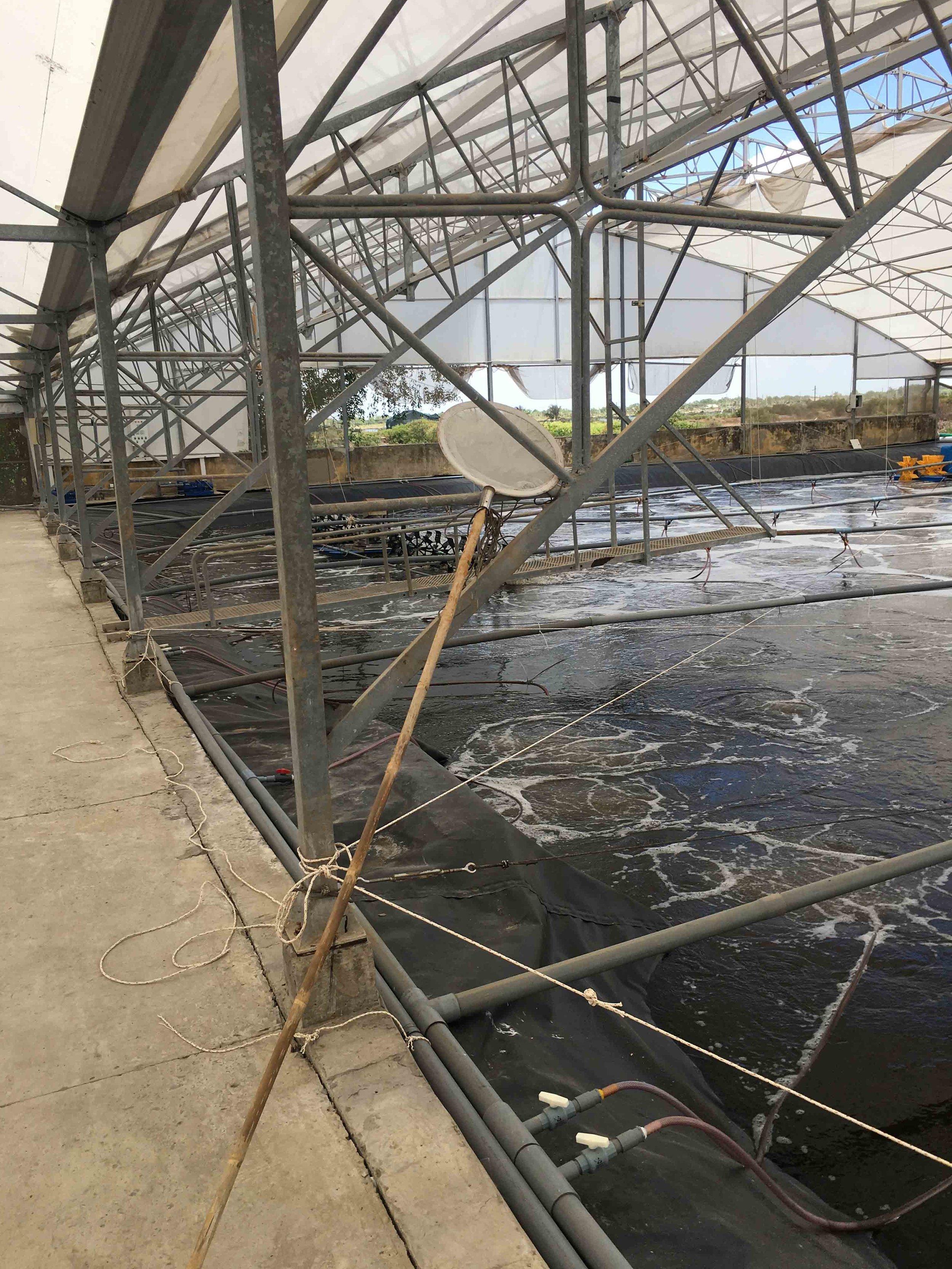Water Sources and logistics
P. vannamei shrimp are farmed in saltwater in land-based ponds. The location of farms is determined by the availability of an appropriate water source. These range from access to saltwater directly from the beach, canal, tidal estuarine rivers, coastal mangroves, and underground aquifer wells.
To host higher biomass, depending on the farm design, most farmers pump new water onto farms and between the treatment reservoirs and production ponds almost everyday. Farmers use a range of pump designs and sizes depending on the water source, required volumes, and demand. Essentially, there are three types of pumps: centrifugal, submersible, and well pumps. These manually controlled pumps pump water via delivery canals or PVC pipes to water treatment reservoirs or directly to production ponds. The delivery canals are constructed using either earth, concrete, or HDPE plastic sheets.
Prior to entering production ponds, water is treated in storage treatment-reservoirs and filtered using a biological and/or mechanical method.
During production, farmers pump new external water onto farms and then treat water in reservoirs prior to production use. In order to control water conditions, avoid external contamination, and reduce frequencies of effluent discharges, farmers reuse and recycle production water within their farms. They do so by designing the internal flow of water to circulate through and between their water treatment reservoirs and production ponds.
Particulate waste from uneaten feed, shrimp feces and other biological solids accumulate in the bottom of ponds during crop cycles. If this waste is not removed or treated, anoxic environments occur and cause mortalities due to stress and proliferative disease. To remove this waste, modern farmers design their ponds so that the internal water hydrodynamics, created by strategically positioned aerators, causes the waste to accumulate in the center of ponds. Here in a central sump, waste can be intermittently removed by either using a manually operated or timed pump, or by flushing the sump via a pipe beneath the pond. Central waste accumulation and removal is only possible with appropriate internal hydrodynamics in smaller round or square ponds while this is not possible in larger rectangle and irregular shaped earth ponds.
Upon harvesting, water is removed to help with collecting shrimp. After a harvest, the remaining water also needs to be removed to allow for effective pond preparation between production cycles. Water removal is done via a range of methods but it depends on the pond design, land contour and pond elevation above exterior water levels. Water is mechanically pumped out or is discharged via gravity through a central sump or a sluice gate on the side of a pond.
Below is a country comparison on farm water sources and the use of varying logistics.
data overview
| www.shrimpfarm.tech by HATCH | Indonesia | India | Ecuador | Thailand | Vietnam | China |
|---|---|---|---|---|---|---|
| Water source Canal, tidal estuarine river, coastal mangroves, beach, underground wells |
Direct beach access | Canal, underground wells | Tidal estuarine river and coastal mangroves | Canal, Coastal mangroves and direct beach access | All | Direct beach access |
| Pump model Submersible, centrifuge, aquifer well pumps or tubular |
Centrifuge | Centrifuge and aquifer well pumps | Submersible | Submersible or centrifuge | Submersible or centrifuge | Submersible |
| Pump size Hp or pipe diameter ‘inch’ |
8 to 10 inch | 7.5 to 12.5 Hp | 140 to 280 Hp | 1 to 20 Hp, 3 to 150 Hp | 1 to 30 Hp | 3 to 20 Hp, 3.5 to 15 Hp |
| Internal water transfer method Gravity or mechanical centrifuge or submersible pump |
Submersible | Centrifuge | Sluice gate | Submersible | Submersible | Submersible |
| Pump operational control Manual or remote control | Manual | Manual | Manual | Manual | Manual | Manual |
| Delivery system to ponds PVC pipes, tarpaulin pipes or delivery canals | PVC pipes or delivery canals | Delivery canals | Delivery canals | Tarpaulin pipes | Tarpaulin pipes | PVC pipes |
| Mechanical filtration None, nylon screen (diameter), drum filter, sand filter or other | Nylon screen, 1 to 3 mm | Nylon screen, 1 to 4 mm | None | Nylon screen, 0.1 to 2.5 mm | Nylon screen, 1 mm | Nylon screen (0.7 to 0.8 mm) or sand filters |
| Biological pretreatment Non or fish culture in primary reservoirs with species | None | None | None | Grouper, barramundi, milk fish or tilapia | Some keep tilapia in treatment ponds | Grouper or Barramundi |
| Water recirculation during production Non or recycled in pond series |
None | None | Recycled in pond series | Recycled in pond series | None | None |
| Wastewater removal during production Non, side drainage with gravity, siphon pump, central drainage sump, central or side centrifugal sump pump | Central drainage sump or central centrifugal sump pump | Side gate drainage with gravity or siphon pump | Side gate drainage | Central drainage sump or central centrifugal sump pump | Side gate drainage with gravity or siphon pump | Side gate drainage or central drainage sump |
| Wastewater removal control Manual, semi-automatic with timer, automatic | Manual | Manual | Manual | Manual or semi-automatic with timer | Manual | Manual |
Summary
Water sources range between regions and countries and are very dependent on the location of farms. The unique feature Indian farms in Andhra Pradesh was that many farmers were using saline water from aquifers. This was likely the case due to easy access of clean, uncontaminated water and to reduce costs of pumping from remote water sources that are shared between neighbouring farmers in a densely populated region.
The preference for inlet pump models to supply water to farms varied across farmers and water sources. Farmers in the most remote regions in Indonesia tend to use home-made and refurbished centrifugal pumps to access clean water directly from the beachfront.
Inlet pump sizes vary between farms within and between countries but most significantly in Ecuador where those farms used huge fixed centrifugal or central axel submersible pumps as they require enormous amounts of water to fill the largest ponds among the six countries. Interestingly, we think the central axel submersible pump design is shared with Thai farmers however, the thai version if this pump is mobile and is sometimes shared between farmers when draining ponds for harvest. These pumps are discussed in the harvesting techniques section of this report.
Delivery or transfer pumps are smaller and farmers prefer to use submersible pumps in lined ponds in Indonesia, Thailand, Vietnam, and China. On the other hand, earthen pond farmers in India use centrifugal pumps while Ecuadorian farmers use gravity and sluice gates to transfer water between ponds.
Delivery systems vary between farms. Larger farms with more ponds use central canals to deliver new water throughout the farm whereas smaller farms with fewer ponds use PVC or tarpaulin pipes to transfer water.
Biological pretreatment and filtration is not common unless farmers have the capacity to adopt a more natural ecosystem approach shrimp farming or have diversified into other value-adding culture species prior to used the water for shrimp production. This is only seen in Thailand, Vietnam, and China. Farmers in the remaining three countries rarely or never use biological methods to filter and treat water.
The most common material used for mechanical filtration is a basic nylon mesh sheet with a diameter ranging between 0.1 to 4mm, though a lot of farmers would use double layers to enhance the filtration grade.
External water sources are often more likely to contain pathogens from the effluent of neighboring farms. To avoid this, recycling production water within farms is a common practice in Thailand and it is also increasingly more popular in Ecuador. Still, this is not yet a practice in the remaining four countries.
Efficient benthic waste removal methods during production is limited to the pond design where particulate solids can be concentrated in the middle of ponds. This is very popular in Thailand, Indonesia, and Chinese modern farmers with smaller round or square lined ponds. These farmers use either a manually controlled or automatic timed pump to suck out waste in central sumps. Other farmers with older non-lined pond designs or large earthen ponds sometimes walk inside the ponds to manually siphon waste. However, most of these farmers only remove waste and treat soil between crop cycles.
In many instances, modern intensive farmers who use aeration face the accumulation of foam on the pond surface. If this foam gets too thick and spreads over too much pond surface area, beneficial phytoplankton populations can crash. With a combination of other excess nutrient levels, this can create stressful conditions for shrimp. To address this, most farmers manually remove the foam using a round nylon scoop net while some farmers in Thailand and China use floating surface pumps that automatically remove foam and other floating solids.
Innovation opportunities
There are a few opportunities to improve water supply and water logistics technology. Specifically, farmers would really like to improve pump efficiency as it is one of the main contributor to farm energy costs. Making pumps more cost efficient, affordable, and durable would be a priority. Additionally, there is a need for enhanced monitoring and control systems. Having pumps controlled by timers with built in sensors to measure and manage pump performance integrated with water flow rates and pond water levels could help farmers avoid unmanned pumps from failing during critical production periods. Specifically, farmers on large remote farms (with either numerous or large ponds) should be able to have remote control over their pumps and make changes based upon the real-time feedback of pond and tidal levels.
Thailand farmers are setting a great example by using pond recirculation systems to recycle and reuse production pond water. We hope that more farmers have the capacity to use unused ponds, and create on-farm water recycling systems. This would lead to a lower environmental footprint of shrimp farming.
Water sources
Inlet pump motors
Delivery and transfer methods
Water filtration
Benthic Treatment
Surface treatment


